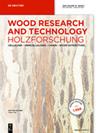利用分子动力学模拟研究木质素二聚体的结构、柔韧性和水合特性
IF 1.6
3区 农林科学
Q2 FORESTRY
引用次数: 0
摘要
木质素是木材和禾本科植物中的一种丰富聚合物,但由于其异质性和复杂的大分子结构,其利用率低于纤维素。虽然人们知道木质素的结构单元,但对它们的连接方式却不甚了解。在这里,分子动力学模拟系统地描述了在原生木质素中发现的七种连接方式。分析了它们对木质素和水结构的影响及其相互作用。研究仅限于由以下常见软木链接连接的愈创木(G-G)二聚体:5-5′、4-O-5′、α-O-4′、β-1′、β-5′、β-O-4′和β-β′。模拟结果表明,连接对构象偏好和木质素与水的相互作用有显著影响。特别是,β-O-4′的行为在构象自由度和与水的相互作用方面都表现出独特的性质。在 β-O-4′ 二聚体中,芳香环之间可能存在 π-π 堆积。分子有两种不同的常见构象,一种是压缩构象,另一种是扩展构象。这些偏好也导致了β-O-4′二聚体对周围水分的不同影响,其中水分靠近链接本身,但从芳香环排出的程度大于其他链接。这些发现对木质素的溶解性及其解聚机制非常重要。本文章由计算机程序翻译,如有差异,请以英文原文为准。
Structure, flexibility and hydration properties of lignin dimers studied with Molecular Dynamics simulations
Lignin is an abundant polymer found in wood and grasses, but due to its heterogeneity and complex macromolecular structure it has been less utilized than cellulose. While the building blocks are known, the way they are linked is less understood. Here, Molecular Dynamics simulations were used to systematically characterize seven linkages found in native lignin. Their influence on lignin and water structure, and their interactions were analyzed. The study is limited to guaiacyl (G-G) dimers connected by the following common softwood linkages; 5-5′, 4-O-5′, α -O-4′, β -1′, β -5′, β -O-4′ and β -β ′. The simulations show that the linkage has a significant effect on conformational preference and lignin-water interaction. Especially, the behavior of the β -O-4′ shows unique properties, both in terms of conformational freedom and interaction with water. Within the β -O-4′ dimer, π –π stacking between the aromatic rings is possible. The molecule has two distinct common conformations, one compressed and one extended. These preferences also lead to a different effect of β -O-4′ dimer on the surrounding water, where water is found close to the linkage itself but expelled from the aromatic rings to a larger extent than the other linkages. These findings are important for lignin solubility as well as its depolymerization mechanisms.
求助全文
通过发布文献求助,成功后即可免费获取论文全文。
去求助
来源期刊

Holzforschung
工程技术-材料科学:纸与木材
CiteScore
4.60
自引率
4.20%
发文量
83
审稿时长
3.3 months
期刊介绍:
Holzforschung is an international scholarly journal that publishes cutting-edge research on the biology, chemistry, physics and technology of wood and wood components. High quality papers about biotechnology and tree genetics are also welcome. Rated year after year as one of the top scientific journals in the category of Pulp and Paper (ISI Journal Citation Index), Holzforschung represents innovative, high quality basic and applied research. The German title reflects the journal''s origins in a long scientific tradition, but all articles are published in English to stimulate and promote cooperation between experts all over the world. Ahead-of-print publishing ensures fastest possible knowledge transfer.
 求助内容:
求助内容: 应助结果提醒方式:
应助结果提醒方式:


